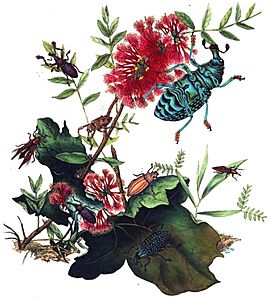Chrysolopus spectabilis facts for kids
Quick facts for kids Chrysolopus spectabilis |
|
|---|---|
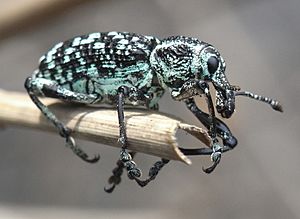 |
|
| Scientific classification | |
| Kingdom: | |
| Phylum: | |
| Class: | |
| Order: | |
| Family: | |
| Genus: |
Chrysolopus
|
| Species: |
C. spectabilis
|
| Binomial name | |
| Chrysolopus spectabilis (Fabricius, 1775)
|
|
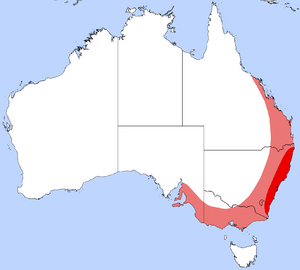 |
|
| Distribution: dark red – core range; light red – peripheral range | |
The Chrysolopus spectabilis is a type of weevil found in south-eastern Australia. People often call it the Botany Bay diamond weevil, Botany Bay diamond beetle, or sapphire weevil. This amazing insect was first discovered during James Cook's first big trip. It was actually the very first insect from Australia that scientists ever officially described! This weevil can grow up to 25 millimeters (about 1 inch) long. It has special shiny green and black scales that make it look like a jewel. You'll only find this weevil living on 28 different kinds of Acacia plants.
Contents
Meet the Diamond Weevil
The Chrysolopus spectabilis was first described by a Danish insect expert named Johan Christian Fabricius in 1775. This made it the very first insect from Australia to be officially named by scientists. Fabricius called it Curculio spectabilis. The word spectabilis means "remarkable" or "admirable" in Latin. He probably saw the weevil in collections from Captain Cook's trips. Later, in 1817, another scientist moved it to the Chrysolopus group, which is its scientific name today. There are now 11 different species in this group, and they all live in the Oceania region. Their colors can be very different, from green to black.
How it Was Discovered
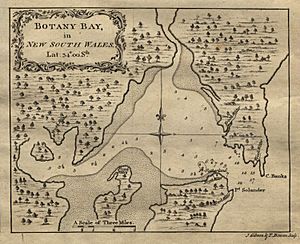
The very first Chrysolopus spectabilis weevil was collected by two naturalists, Joseph Banks and Daniel Solander. This happened between April and August in 1770, during James Cook's first big trip to the South Pacific. It was one of only five insects that this expedition collected! The others were a butterfly, a type of ant called Myrmecia gulosa, and two flies. Joseph Banks didn't find many insects in Australia. He wrote that "Of insects here were but few sorts and among them only the ants were troublesome to us."
The ship's logs didn't say exactly where these insects were found. Even though it's called the "Botany Bay weevil," it probably wasn't found near Botany Bay. It's usually too cold and wet there in April. It's more likely that it was found in the warmer, drier area around Cooktown, Queensland, which the expedition visited in August. After people started settling in Australia in 1788, the weevil was often seen near Sydney during the summer. This is why it got its common names.
The name "diamond weevil" was first used in 1805 by Edward Donovan. He named it after a Brazilian insect called the "diamond beetle," which was already famous in Europe. Both insects looked similar with their shiny colors. But even though they look alike, these two weevils are not closely related at all!
After it was discovered, the Chrysolopus spectabilis was a very popular item for insect collections. People loved its unusual look. The first weevil collected from Cook's trip is now kept at the Natural History Museum, London in London. It's still in good shape, even though some of its leg parts are missing.
What it Looks Like
The Chrysolopus spectabilis has a long, oval-shaped body. It can be from 15 to 25 millimeters long. Its hard wing covers, called elytra, are black. They have shiny, metallic green spots that are not in a regular pattern. The underside of its body is a dull green, and a white or green line runs along its sides. Its head, chest, and legs are black, with some metallic green marks. The weevil's colors can change during the year. Weevils that appear later in the season often have a bluer color.
The weevil's snout is about as long as its bell-shaped chest area and is very curved. Its bent antennae grow from the middle of its snout and have a small club at the end. Its compound eyes stick out a little. The wing covers have rows of small grooves with slight dips. The weevil's belly is also covered with tiny scales. Its strong legs have thick hair on their feet, but they don't have claws.
The young weevils, called larvae or grubs, are 40 to 50 millimeters long. They are white, round, and wrinkled. They have a few hairs on their sides and a reddish-brown head with black jaws. Scientists haven't described the pupa (the stage between larva and adult) yet.
Where it Lives
The Chrysolopus spectabilis lives in the eastern and southern parts of Australia. Its home range stretches from the coast of Queensland down to Victoria and the eastern parts of South Australia. It's most common in eastern New South Wales, especially around Sydney and near the foothills of the Great Dividing Range.
Adult weevils are active both during the day and at night. They are mostly seen during the warmer months, from November to March. During this time, you can often spot C. spectabilis in towns and woodlands where there's a moderate amount of rain. They especially like areas with Acacia plants. In open areas, like northern New South Wales, they prefer Acacia species with flattened leaf stalks (called phyllodia). But in more wooded areas, like the Blue Mountains, they prefer Acacia species with leaves divided into many small leaflets. Adult beetles have been seen on 28 different Acacia species. However, the larvae have only been found on seven of these species. Scientists think the larvae probably eat the same plants as the adults.
Life Cycle
These beetles usually grow into adults in less than a year. Female weevils make up to 20 small holes close together in the stem of an Acacia plant. They do this right above the ground. They lay one egg in each hole. After the eggs hatch, the grubs dig deeper into one of the plant's main roots. The adults come out of the plant in the spring in cooler areas. But in warmer, subtropical places, they can come out all year round. They chew their way out of the plant, leaving their empty pupa case behind.
What it Eats and How it Survives
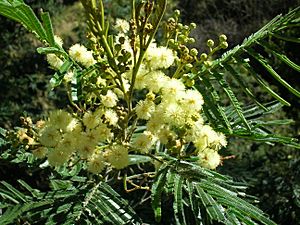
The Chrysolopus spectabilis eats almost only specific types of Acacia plants. These include the Cootamundra wattle (Acacia baileyana), the silver wattle (Acacia dealbata), the Australian blackwood (Acacia melanoxylon), and the golden wattle (Acacia longifolia). The beetles choose young plants, usually about 50 to 150 centimeters (20 to 60 inches) tall, before they have flowered. They use their long snout and strong mouthparts to make holes in the stem and leaves. This helps them reach the sap and create places to lay their eggs.
In south-eastern Australia, C. spectabilis can sometimes cause problems for acacia plantations. Adult weevils can damage new plant shoots. The larvae can also make it harder for the plant to take in water. Sometimes, the adults can even cause a tree to die by chewing a ring around its bark. Even though it has bright colors, C. spectabilis is not poisonous. It is very aware of its surroundings. If it feels danger, it will either drop to the ground and pretend to be dead, or it will hold onto the plant very tightly with its legs.


